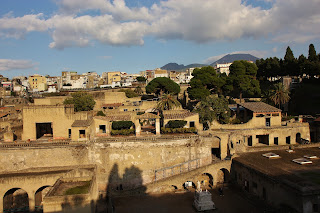On Veteran's Day, we ventured with Nana and Aunt Laura to nearby Herculaneum, a fascinating ancient Roman town destroyed when Mt. Vesuvius erupted in 79 AD, despite having been inactive for more than 800 years prior. The town was buried under approximately 50 feet of mud and ash and remained undiscovered for more than 1600 years. Then, in 1709 it was accidentally discovered by workers digging a well.
Pompei, a neighboring city, is bigger and more famous for having been destroyed by the same volcano eruption, since it received the brunt of the initial volcanic ash destruction. However, Herculaneum (pictured here) appears to be more well preserved since it was covered later and mostly by a type of volcanic mud and ash mixture.
It was long thought that most inhabitants of Herculaneum had escaped, since it was a relatively small city, more wealthy, and there was more time to evacuate as compared to Pompei. However, since 1981, 300 skeletons have been excavated from near the seashore, which is most notable because Romans generally cremated the dead and this was the first time Roman remains had been available for scientific study.
 |
| Mt. Vesuvius looms in the background |
 |
| Ancient Roman snack bar |
It was amazing to see how much of the original structures, wood, marble, and even paintings were preserved for all these years, encased in the volcanic mud. My personal favorite, of course, was the snack bar seen here--an ancient type of fast food and the original Mediterranean diet. How very modern!
 |
| Original marble flooring |
 |
| Original painting |








No comments:
Post a Comment